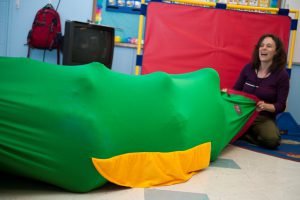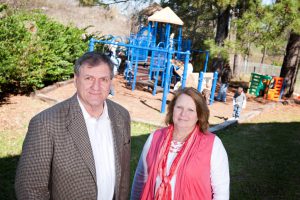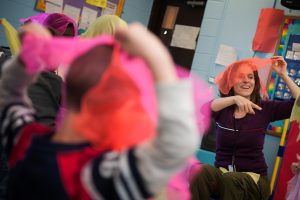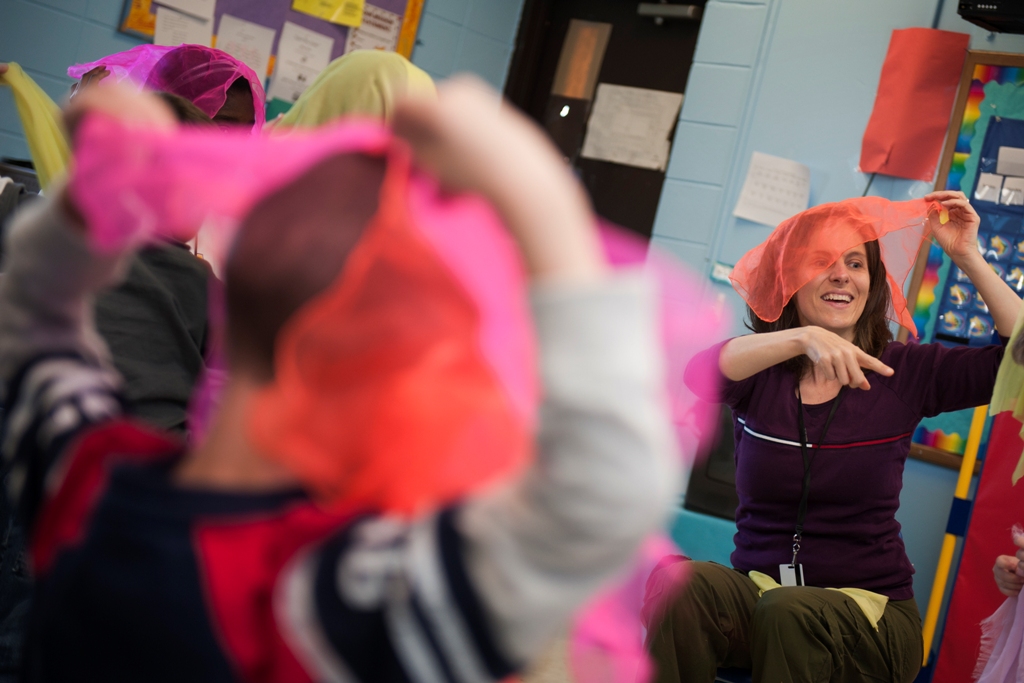By Chris Bryant
Photographs by Jeff Hanson

“Water, please.”
Such simple requests, when uttered by a child, rarely land in the long-term memory of the responding adult.
But at The University of Alabama’s Brewer Porch Children’s Center, such two-word requests can be exhilarating – a moment worthy of spontaneous celebration.
Such was the case recently, Patty McKnight recalls, when a 9-year-old boy, a child who no one on staff had heard voice anything other than non-decipherable sounds, became thirsty, and, for the first time – following months of speech and other therapies – asked a center teacher for a drink.
“Water, please.”
“These moments make everything so meaningful, so valuable and so rewarding,” says McKnight, director of the center’s Community Autism Intervention Program – one of its six programs providing services to children with emotional and behavioral disturbances.
Dr. James Thompson, executive director of the Brewer Porch Children’s Center, has collected a multitude of such inspiring moments during his 32-year career in this position. But, he’s also looked into the eyes of parents, and sometimes children who have no parents, and seen the devastating absence of an emotion that no one should be without.
“If you don’t have hope, you don’t have anything,” Thompson says. “That’s part of our job – kids who have no hope … or very little – to inject that into their lives.”
A VARIETY OF NEEDS
About 200 children and adolescents receive help from this mental health treatment facility each year, Thompson says. The degree of hope injection necessary varies significantly depending on the individual child.
Just within the autism program, alone, the variety of needs is broad.
“We serve children who are totally non-communicative in any way to children who are …,” McKnight begins a slight smile, “more verbal than we like sometimes.”
Social workers, consulting psychiatrists, dietitians, psychological assistants, special education teachers, nurses, counselors and other mental health workers are among the 300 plus-member staff who work with children ranging from pre-schoolers to high-school seniors. Of those, about 150 are full-time employees of the center.

The center, which also serves as a state mental health training center and a teaching clinic for UA and other college students, is housed in nine buildings on a 60-acre campus in central Tuscaloosa, some six miles from UA’s campus and adjacent to the Tuscaloosa Veteran’s Hospital.
Although the focus is on the children, Thompson says the most effective way to help them is to help their entire family.
“The parents are part of the treatment process here,” Thompson says.
McKnight concurs.
“One of the biggest keys to success in this program is parent involvement,” she says of the autism intervention program. “A parent can’t do it by themselves, but we can’t do it by ourselves either. We really encourage the parents to go through training with us on the different techniques we use with children and how they can use those same techniques at home.”
KID-FRIENDLY
Beverly Hale, mom of a 5-year-old boy enrolled at Brewer Porch, says her son has made much progress since entering the program about two years ago, and expressed appreciation for the professionalism and enthusiasm the Center’s staff brings to their efforts.
“They are so accommodating, and they truly and genuinely want the best for your child,” Hale says. “You know you are in a good place when the workers and the aides are just as excited when your child is doing well as the parents are.”
And her son is doing well. Hale and her son’s dad anticipate their child will begin mainstream kindergarten in the fall.
“I can’t say enough good things about Brewer Porch,” Hale says. “Had we not had early intervention, had we not had Brewer Porch from the time he was three, I don’t know where we would be.”
“They incorporate what our son is good at to help improve his weaknesses.” Communication is the child’s biggest challenge, Hale says, and has been since he stopped talking at about 15 months. About five months later, the Hales learned why. Their son was diagnosed with autism.
“He has responded so extremely well to everything they have done,” Hale says. “It’s really a fun, kid-friendly environment. He loves school.
“What I love about Brewer Porch, they have almost one-on-one instruction. In addition to the teachers, they have so many aides.”
PROVIDING HOPE FOR 40+ YEARS
In addition to the autism program that the Hales’ son participates in, the center offers five other programs: a residential treatment facility for children statewide in need of round-the-clock mental health care; an outpatient day treatment program, operated in conjunction with the local school systems, to assist with behavior skills; an adolescent adaptive skills program to strengthen children’s academic skills in a therapeutic environment; a short-term treatment and evaluation program, as an alternative to psychiatric hospitalization; and a therapeutic foster care program, which recruits and provides support and consultation to foster parents raising children with mental health needs across a seven-county area of west-central Alabama. Services are provided for children and adolescents from ages 3 to 21.
The center, a division of UA’s College of Arts and Sciences, was established by the state’s legislature in 1970 after Ralph Porch, a legislator, advocated for such services. In outlining the state’s needs for the center in a talk, Porch peppered his approach with personal references to his own son, Mark, Thompson recalls.
The state’s then governor, Albert Brewer, and then UA President David Matthews and the late Bert Bank, a former broadcasting executive and state legislator, were among the early supporters of establishing the center, Thompson says.

Initially, the center was housed on campus in a building that stood across from Tutwiler Hall, Thompson says. It began with a $500,000 annual budget and has grown to a $9 million budget, he says. About half of that budget comes from Medicaid, about 40 percent from contracts and grants and about 10 percent from UA, Thompson says. Costs associated with services at the center are based on a sliding scale dependent upon the family’s income.
SPECIAL PEOPLE
Thompson says he has admiration for the center’s staff and all those who work closely with special needs children.
“It takes a special person to work with these children on a day in and day out basis and to do it well. The people need to be compassionate, but they also need to be able to provide therapeutics. It’s an art and a science, and that’s where the training comes in.”
McKnight, a 14-year veteran of the center, describes herself as “fortunate” to work at Brewer Porch.
“Not many people get to work in a field they are passionate about,” McKnight says.
The national increase in autism diagnoses – the condition is now said to affect one in every 110 children – is certainly reflected in requests for the center’s services, McKnight says.
“Demand has spiked three times in 10 years,” she says. “We served more children this year (about 60 in the autism program, alone) than we ever have. We have longer waiting lists than we ever have. I don’t see it leveling off.”
Difficulties in social interaction – including knowing how to make friends – poor conversation skills and obsessive interests are characteristics of people with autism spectrum disorders. Individuals with an ASD have IQ scores from the range of mental retardation to giftedness.
OATMEAL ONLY DIETS
“It’s such an intensive disorder,” McKnight says. “You have to have empathy for the family because there are so many characteristics and associated symptoms of the disorder that it affects everything in their lives.”
Language and social skills are at the top of the list, she says.
“The social world is just a huge part of everyone’s life. It affects parents going to church and taking their families out to eat and to shows and plays and other social events.”
Many of the children experience sensory impairments, McKnight says.
“This can affect the kind of clothes they can wear. They can become much more over-stimulated to sound and lighting.” The sensory impairments can also affect their diets.
“We have children who might come to us, and they have only eaten oatmeal seven days a week, three times a day for years.”

Sleeping, gastrointestinal and seizure disorders sometimes accompany the syndrome, and, even more frequently, restrictive and repetitive patterns of behavior and interests are challenges.
“They can view the world totally different than we do. Educationally, there are associated learning impairments which affect the way they learn. It doesn’t keep them from learning. It just affects the modality of teaching that they need.”
“The lack of ability to communicate causes our kids to be more frustrated or more anxious. It can even cause, in older children, some depression.”
DANCE TO THE BEAT
The center, McKnight says, draws from a host of researched and accepted intervention techniques from a variety of programs, rather than holding fast to a single program. The state is working to adopt a comprehensive, holistic approach for autism intervention programs and to make it uniform, statewide, but, until then, McKnight says borrowing different components from a variety of programs has its benefits.
“Because what works for Johnny isn’t necessarily going to work for Suzie, and just because it worked yesterday doesn’t mean it’s going to work today.”
Just this year, the center added dance and music therapy to the physical therapy and other interventions offered on site. “It has made a fantastic difference,” McKnight says, “in helping the children to excel in the autism-deficient areas.”

Hale, the mom of the 5-year old, says she’s appreciative her family found a way to help her son excel that did not require relocating.
“We are so excited that in Alabama we are able to receive services. We are able to go ahead and treat the children here and not have to move to a big city. We don’t have to move to Birmingham. We don’t have to move to Atlanta or Los Angeles. We are really fortunate.”
Helping every child reach the best possible outcome for him or her is the goal, McKnight says.
“Ultimately, we want every child to communicate verbally. The reality is, all of them may not. And for some, it may take several years.”
Achieving goals that are years in the making can result in some sweet celebrations, McKnight says.
“The most rewarding times are when you see the child hit a milestone.”
And significant milestones can sometimes be encompassed in a single request.
“Water please.”
Contact
Christoffer Feemster or Linda Hill, UA Public Relations, 205/348-8325, lhill@ur.ua.edu
Source
Barbara Schlichtman, UA Office of Student Media, 205/348-6453, bsschlichtman@sa.ua.edu
